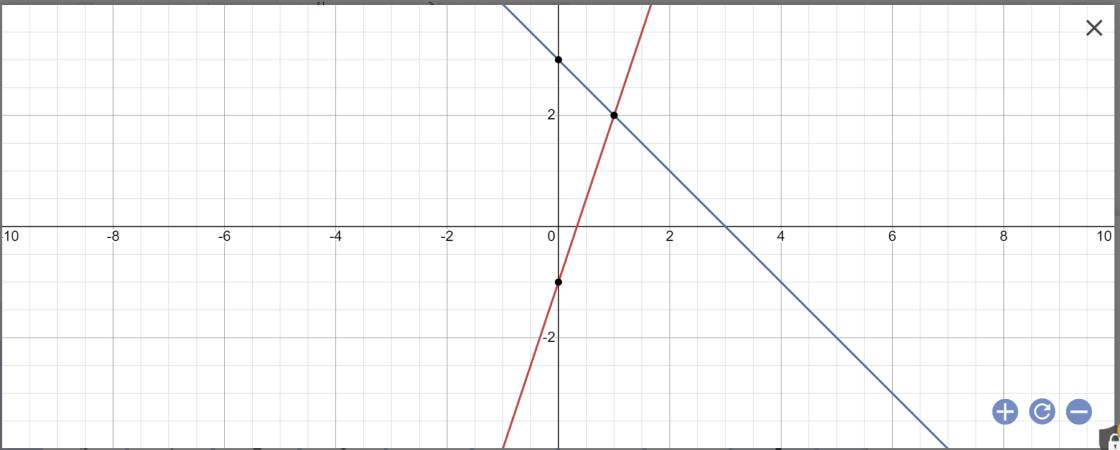


Hãy nhập câu hỏi của bạn vào đây, nếu là tài khoản VIP, bạn sẽ được ưu tiên trả lời.




\(a,-1< 0\Leftrightarrow\left(d'\right)\text{ nghịch biến trên }R\\ b,\text{PT hoành độ giao điểm: }x=-x+2\Leftrightarrow x=1\Leftrightarrow y=1\Leftrightarrow A\left(1;1\right)\\ \text{Vậy }A\left(1;1\right)\text{ là giao 2 đths}\\ c,\text{3 đt đồng quy }\Leftrightarrow A\left(1;1\right)\in\left(d''\right)\\ \Leftrightarrow m-1+2m=1\\ \Leftrightarrow3m=2\Leftrightarrow m=\dfrac{2}{3}\)

a) Để đồ thị hàm số \(y=ax^2\) đi qua điểm A(4;4) thì
Thay x=4 và y=4 vào hàm số \(y=ax^2\), ta được:
\(a\cdot4^2=4\)
\(\Leftrightarrow a\cdot16=4\)
hay \(a=\dfrac{1}{4}\)
a, - Thay tọa độ điểm A vào hàm số ta được : \(4^2.a=4\)
\(\Rightarrow a=\dfrac{1}{4}\)
b, Thay a vào hàm số ta được : \(y=\dfrac{1}{4}x^2\)
- Ta có đồ thì của hai hàm số :
c, - Xét phương trình hoành độ giao điểm :\(\dfrac{1}{4}x^2=-\dfrac{1}{2}x\)
\(\Leftrightarrow x^2+2x=0\)
\(\Leftrightarrow\left[{}\begin{matrix}x=0\\x=-2\end{matrix}\right.\)
Vậy hai hàm số trên cắt nhau tại hai điểm : \(\left(0;0\right);\left(-2;1\right)\)

a: 
b: Tọa độ A là:
\(\left\{{}\begin{matrix}y=0\\3x-1=0\end{matrix}\right.\)
=>\(\left\{{}\begin{matrix}x=\dfrac{1}{3}\\y=0\end{matrix}\right.\)
Vậy: A(1/3;0)
Tọa độ B là:
\(\left\{{}\begin{matrix}y=0\\-x+3=0\end{matrix}\right.\)
=>\(\left\{{}\begin{matrix}y=0\\-x=-3\end{matrix}\right.\Leftrightarrow\left\{{}\begin{matrix}y=0\\x=3\end{matrix}\right.\)
Vậy: B(3;0)
Tọa độ C là:
\(\left\{{}\begin{matrix}3x-1=-x+3\\y=3x-1\end{matrix}\right.\)
=>\(\left\{{}\begin{matrix}4x=4\\y=3x-1\end{matrix}\right.\Leftrightarrow\left\{{}\begin{matrix}x=1\\y=3\cdot1-1=2\end{matrix}\right.\)
Vậy: C(1;2)
c: Gọi \(\alpha\) là góc tạo bởi (d1) với trục Ox
\(tan\alpha=a=3\)
=>\(\alpha\simeq71^033'\)

b: Tọa độ giao điểm là:
\(\left\{{}\begin{matrix}-2x+3=x+2\\y=x+2\end{matrix}\right.\Leftrightarrow\left\{{}\begin{matrix}x=\dfrac{1}{3}\\y=\dfrac{7}{3}\end{matrix}\right.\)

\(b,\text{PT hoành độ giao điểm: }\dfrac{1}{2}x=-x-6\\ \Leftrightarrow\dfrac{3}{2}x=6\Leftrightarrow x=4\Leftrightarrow y=2\Leftrightarrow A\left(4;2\right)\\ \text{Vậy }A\left(4;2\right)\text{ là giao điểm 2 đths}\)

a, bạn tự vẽ
b, Hoành độ giao điểm tm pt
\(x^2+x-2=0\)ta có a + b + c = 1 + 1 - 2 = 0
Vậy pt có 2 nghiệm x = 1 ; x = 2
Với x = 1 => y = -1
Với x = 2 => y = -4
Vậy (P) cắt (d) tại A(1;-1) ; B(2;-4)